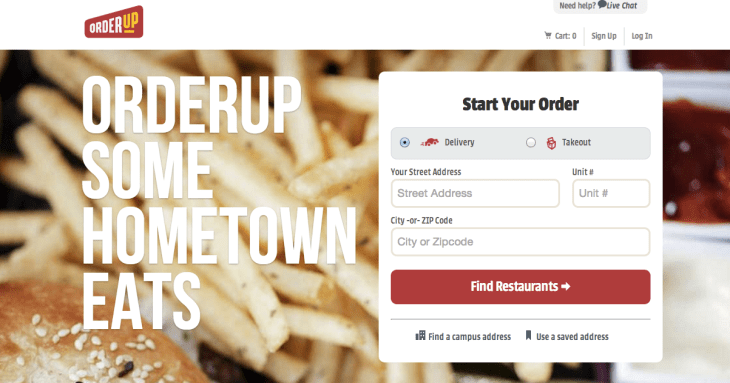One of the big bones of contention with a lot of consumer services from startups is that they tend to focus on urban areas — the idea being that big cities give them a better shot at achieving critical mass and tapping into populations of overworked people with more disposable income. A startup called OrderUp based out of Baltimore is bucking that trend with a food ordering and delivery service focused specifically on smaller towns — and it’s already profitable.
Today, the company is announcing $7 million in funding, led by Steve Cases’s Revolution Ventures and Tim O’Shaughnessy, the co-founder of LivingSocial — entrepreneurs that have, in their time, understood the power of building businesses outside of urban areas.
The Series A round takes the total raised by OrderUp to $8.25 million, Chris Jeffery, co-founder and CEO of OrderUp, tells me. Previous investors included Chris Brandenburg, the co-founder of Millennial Media.
The company, formerly known as LocalUp, says that right now it serves 35 markets, and it will be using the funding to expand that significantly, all without expanding into massive urban centers. “OrderUp has identified 500-plus U.S. markets that fit our current product and model,” Jeffery says. “We are focused on these markets for the time being.” All the same, they will also be using the funding to open two more offices, one in Boulder, and the other in the most urban center of all urban centers — New York City.
“Consumers love the convenience of ordering online. Yet, outside the major metropolitan markets, it’s shockingly difficult to find online food delivery options,” said Tige Savage, managing partner at Revolution Ventures, who is joining the startup’s board as part of this investment. “OrderUp allows restaurants in small towns nationwide to cost-effectively join the digital age through an innovative ordering and delivery model. Restaurants love it and consumers do, too.”
There is also growth to be had simply among its existing customer base. The company claims to fulfil over 10,000 food deliveries each week, but this is just the tip of the iceberg.
“Deliveries made by OrderUp driver partners are a small percentage of our orders, but by far the fastest growing segment of our business. The other transactions are deliveries fulfilled by the restaurants themselves that have a fleet of drivers,” Jeffery says. “OrderUp’s business model is flexible so restaurants that want to use our technology and/or OrderUp driver partners can; some only want a piece of the solution. We work with restaurants that have their own delivery operation and want help reaching more consumers; restaurants that currently have their own delivery operation, but want to offload it completely; or restaurants that have never delivered before.”
In doing so, Jeffery says OrderUp takes “a small commission on each transaction,” but doesn’t specify what it is. The company currently has 55 employees along with “hundreds” of delivery people, who work on a contract basis, similar to other companies working in the delivery category like Uber, Lyft, TaskRabbit and Postmates.
The race is on in the food-delivery land-grab, to be sure, but there is also a big push towards consolidation. In the U.S., GrubHub and Seamless have come together into a single company, and in Europe, Delivery Hero has recently eaten up its big German rival Pizza.de and is now valued at over $1 billion. At the same time, other companies coming at logistics from other categories outside of food — think Amazon here, but also Uber — will also likely make deeper inroads and become more direct competitors. All of this could present opportunities for OrderUp in that it could make the startup into an acquisition target for inorganic growth, but also challenges as these others compete aggressively on price.
Jeffery says that for now this will not spur OrderUp into any other categories. “We like food, our customers are asking for access to restaurant options, and our restaurant and driver partners are asking for more tools,” he says. “We will stay focused in food delivery in the markets we’ve identified and iterate on that for the foreseeable future.”
